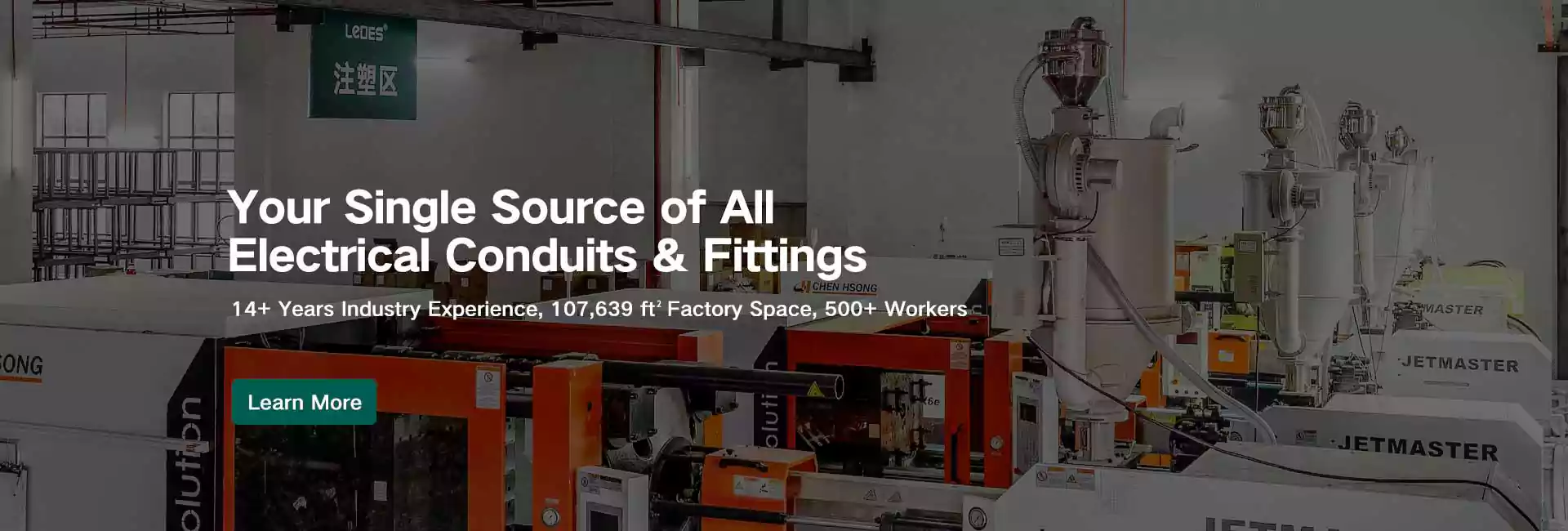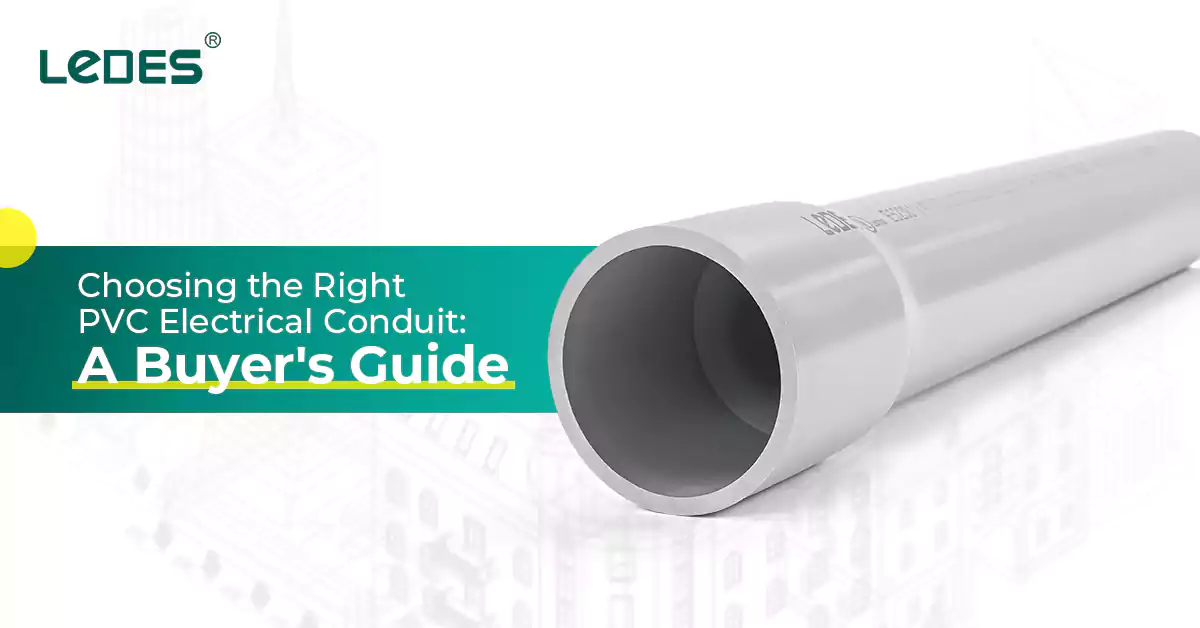
جدول المحتويات
قناة كهربائية plays a vital role in protecting and routing wiring in a wide range of environments, from homes and offices to hospitals, data centers, and industrial sites. The right conduit ensures electrical safety, prevents damage, and supports long-term system reliability. But with a variety of conduit materials available, such as EMT, RMC, IMC, FMC, ENT, and PVC, knowing which one to use can be challenging.
Each conduit type comes with specific advantages, limitations, and code considerations based on installation environments, voltage levels, and mechanical or fire protection needs. Among them, PVC conduit has become one of the most popular choices due to its lightweight design, corrosion resistance, cost-efficiency, and ease of installation.
This guide will help you better understand all the common electrical conduit types, and get to know about PVC conduit’s specifications, standards, applications, and installation best practices etc. Whether you’re a contractor, engineer, facility planner, or a procurement specialist, this guide will help you choose the right PVC conduit solution for your project safely, effectively, and in compliance with code.
فهم القناة الكهربائية
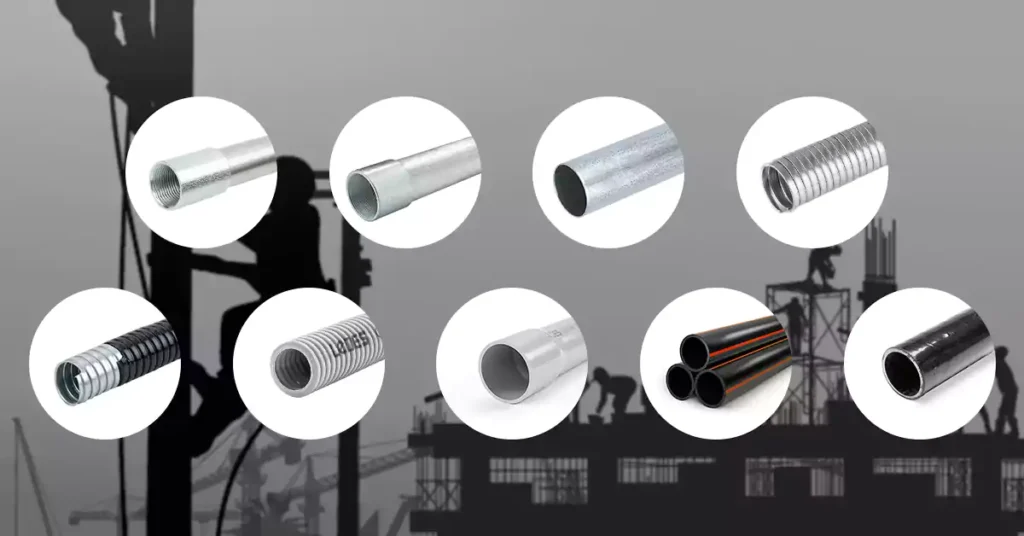
There are many different types of electrical conduits, and each conduit type is designed to meet specific environmental, mechanical, and regulatory requirements. Better understand the suitable applications of each type before buying them for your project.
نصائح احترافية: Want to know the top 10 types of electrical conduit features and applications? You can click the link above to read our last post.
9 Common Types of Electrical Conduit
القناة المعدنية الصلبة (RMC)
Made of galvanized steel or aluminum, RMC is the heaviest and most durable metal conduit, offering superior protection in high-risk or exposed environments.
الايجابيات:
Excellent mechanical strength
Strong resistance to physical damage
Suitable for outdoor and hazardous locations
Can be used as a grounding conductor
سلبيات:
Heavy and difficult to install
Expensive
Requires threading tools and fittings
القناة المعدنية المتوسطة (IMC)
IMC is made of steel, it is a lighter alternative to RMC, offering a balance between strength and ease of handling.
الايجابيات:
أخف من RMC ولكن لا يزال قويا
Approved for indoor and outdoor use
Lower cost than RMC
سلبيات:
Still requires special tools for cutting and threading
Heavier than nonmetallic options
الأنابيب المعدنية الكهربائية (EMT)
Made of steel (sometimes aluminum), also called “thin-wall” conduit, EMT is lightweight and easy to bend, widely used in commercial and light industrial settings for indoor applications.
الايجابيات:
Lightweight and easy to bend
Cost-effective
Clean appearance for exposed runs
Recyclable and easy to ground
سلبيات:
Susceptible to corrosion in wet environments
Not rated for direct burial
Lower mechanical strength than RMC/IMC
الأنابيب المعدنية المرنة (FMC)
A spiral metal conduit that allows flexibility. Commonly used in short runs to connect fixtures or motors to rigid conduits.
الايجابيات:
Flexible and easy to route in tight spaces
Quick to install
Absorbs vibration
سلبيات:
Not waterproof
Lower crush resistance
Requires careful grounding
Liquid-Tight Flexible Conduit (LFMC)
Similar to FMC but with a waterproof plastic jacket. It is used in wet or outdoor locations requiring flexibility and moisture protection.
الايجابيات:
Water-resistant and weatherproof
Maintains flexibility
Suitable for outdoor, wet, or oily environments
سلبيات:
Expensive compared to standard FMC
Heavier than nonmetallic flexible options
Requires watertight fittings
الأنابيب الكهربائية غير المعدنية (ENT)
Made of PVC, is a pliable, قناة بلاستيكية مموجة, mainly for indoor, in-wall, or ceiling installations in residential and light commercial construction. ENT is quick to install but limited to certain environments.
الايجابيات:
Lightweight and easy to install
No need for bending tools
Non-conductive and corrosion-resistant
سلبيات:
Not UV-resistant
Limited to dry, protected areas
Lower mechanical strength
قناة بي في سي
Made of rigid PVC, أنابيب بلاستيكية is nonmetallic and widely used for underground, outdoor, or corrosive environments due to its affordability and corrosion resistance.
الايجابيات:
Corrosion-resistant and non-conductive
Lightweight and inexpensive
Easy to cut and join with solvent cement
Available in rigid and flexible forms
Ideal for underground or wet locations
سلبيات:
Limited temperature resistance
Less impact-resistant than metal
Requires expansion joints in long runs
Fire-rated types needed for some environments
High-Density Polyethylene (HDPE) Conduit
Made of HDPE plastic, best for Long underground duct runs (telecom, power, fiber)
الايجابيات:
Excellent chemical and moisture resistance
Long coil lengths reduce jointing
Flexible and crush-resistant
Suitable for trenchless installations (e.g., directional drilling)
سلبيات:
Requires fusion welding or special fittings
Not suitable for high-temperature areas
Higher initial equipment cost (fusion tools)
Fiberglass Reinforced Conduit (FRC or RTRC)
مادة: Fiberglass-reinforced thermosetting resin
Best for: Corrosive, high-temperature, or chemically aggressive environments
الايجابيات:
Exceptional corrosion and heat resistance
Lightweight compared to metal
Fire-resistant options available
Suitable for utilities, chemical plants, tunnels
سلبيات:
High material and installation cost
Brittle under impact
Specialized fittings and adhesives needed
Summary Table:
Here are 9 common types of electrical conduit comparing list.
نوع القناة | مادة | المرونة | الايجابيات | سلبيات | أفضل استخدام |
آر إم سي | الصلب المجلفن | جامد | أقصى قوة مقاومة للحريق | ثقيل، باهظ الثمن | شديدة التحمل، خارجية، صناعية |
اي ام سي | فُولاَذ | جامد | أخف من RMC، ومقاوم للتآكل | لا يزال ثقيلًا، ويتطلب الخيط | تجاري/صناعي |
فني طوارئ طبية | الفولاذ/الألومنيوم | شبه صلب | خفيف الوزن، سهل الانحناء | غير مخصص للاستخدام في حالة رطبة أو مدفونة | مسارات داخلية مكشوفة |
شركة اف ام سي | فُولاَذ | مرن | مرنة، امتصاص الاهتزاز | غير مقاوم للماء، ضعيف أمام الصدمات | المحركات والأضواء |
LFMC | المعدن + السترة | مرن | مقاوم للماء والزيت، مرن | تكلفة عالية، ثقيلة | المناطق الخارجية الرطبة |
الأنف والأذن والحنجرة | بلاستيك بي في سي | مرن | تثبيت سريع وخفيف الوزن | للاستخدام الداخلي فقط، قوة منخفضة | داخل الحائط، سكني |
بولي كلوريد الفينيل | بلاستيك بي في سي | جامد | خفيف الوزن، منخفض التكلفة، ومقاوم للتآكل | مقاومة محدودة للحرارة/النار | تحت الأرض، في الهواء الطلق، تآكلي |
البولي إثيلين عالي الكثافة | بلاستيك البولي إيثيلين عالي الكثافة | مرن | مسافات طويلة، مقاومة للسحق، ومقاومة للتآكل | الأدوات اللازمة للاندماج، غير مقاومة للحريق | قنوات تحت الأرض |
مركز أبحاث الاتصالات الراديوية | الراتنج + الألياف الزجاجية | جامد | مقاومة ممتازة للمواد الكيميائية/الحرائق | غالي الثمن، هش تحت التأثير | مواد كيميائية قاسية/حرارة عالية |
Why Choose PVC Conduit?
PVC conduit has earned its reputation as one of the most versatile and cost-effective solutions for electrical wiring protection. It’s ideal for underground ducting, outdoor exposure, and corrosive environments, common in construction, wastewater treatment, agriculture, and solar power systems.
Key Advantages of PVC Conduit:
Corrosion Resistant: Withstands moisture, salts, acids, and chemicals
فعاله من حيث التكلفه: Lower material and labor cost than metallic or specialty conduits
وزن خفيف: Easier handling reduces labor effort
غير موصل: Offers built-in electrical insulation
Easy to Join: Simple solvent cement connection method—no threading needed
Direct Burial & UV-Resistant Versions Available
Limitations of PVC Conduit:
Less Impact Resistance: Rigid PVC conduit can not offer high strength as rigid metal conduit, not ideal for high-traffic or exposed mechanical areas
Lower Temperature Tolerance: Deforms at high heat
Thermal Expansion: May require expansion fittings in outdoor runs
Fire Ratings Not Inherent: Must choose fire-rated types for code-critical areas
PVC Vs. EMT Vs. RMC Vs. HDPE Vs. Fiberglass Conduit
ميزة | بولي كلوريد الفينيل | فني طوارئ طبية | آر إم سي | البولي إثيلين عالي الكثافة | الألياف الزجاجية |
مادة | بلاستيك بي في سي | الفولاذ/الألومنيوم | الفولاذ المجلفن | بلاستيك البولي إيثيلين عالي الكثافة | الراتنج + الألياف الزجاجية |
المقاومة للتآكل | ممتاز | معتدل | جيد | ممتاز | ممتاز |
القوة الميكانيكية | معتدل | معتدل | ممتاز | جيد | جيد |
المرونة | جامد | شبه صلب | جامد | مرن | جامد |
مقاومة درجة الحرارة | محدود | معتدل | ممتاز | معتدل | ممتاز |
خيارات مقاومة الحريق | متاح | نعم | نعم | لا | نعم |
تمت الموافقة على مترو الأنفاق | نعم | لا | نعم | نعم | نعم |
تعقيد التثبيت | سهل | واسطة | صعب | معتدل | عالي |
يكلف | قليل | واسطة | عالي | واسطة | عالي |
In summary, PVC conduit offers the best balance of affordability, corrosion resistance, and installation simplicity, making it a leading choice for a wide range of standard and outdoor wiring needs. While it may not suit high-heat or high-impact environments, it excels in underground, damp, or chemically aggressive installations where nonmetallic performance is key.
Code Compliance for PVC Electrical Conduit
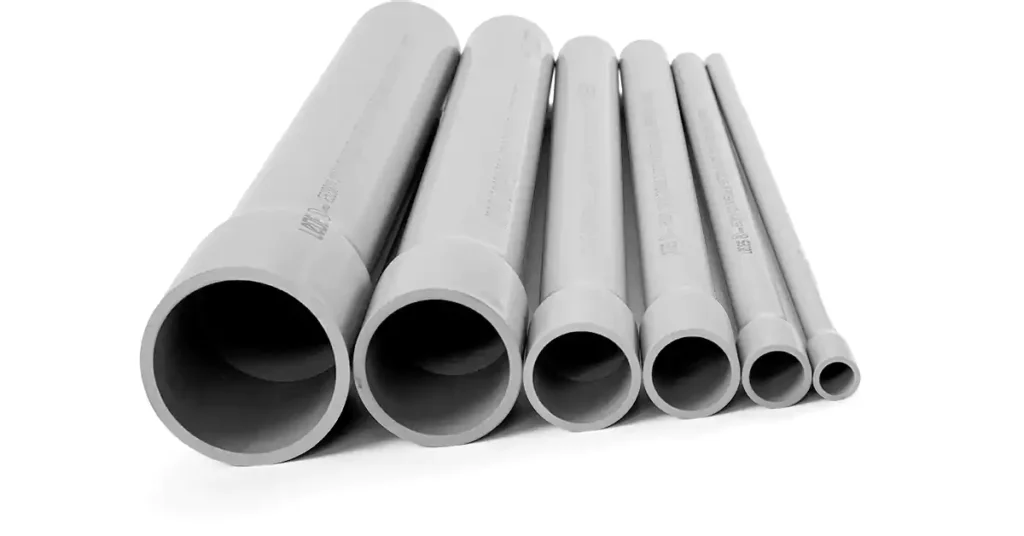
Choosing the right PVC electrical conduit goes beyond just selecting the right type and material, it must also meet local and international electrical codes and product standards to ensure safety, legal compliance, and long-term performance. Authorities in different countries outline specific requirements for conduit systems, including how they are constructed, tested, marked, and installed.
Here’s a brief overview of the major standards that govern PVC conduit:
National Electrical Code (NEC – U.S.)
Published by the National Fire Protection Association (NFPA) as NFPA 70, the NEC sets the foundational rules for electrical wiring and equipment installations in the United States.
Article 352 outlines the requirements for PVC conduit, here are some of them:
- Material must be nonmetallic, flame-retardant, and resistant to sunlight (if exposed)
- Requires use of approved, listed (e.g., UL 651) conduit and fittings
- Expansion fittings are required where significant thermal movement is expected
- Specific support intervals (e.g., every 3 feet for horizontal runs unless otherwise specified)
- Conductors must be rated for the environment (e.g., wet or underground)
ملحوظات: Are you a builder or electrical contractor in the United States? Read this expert guide to the 2025 edition of the UL 651 standard to quickly understand the sizing, performance and installation requirements of UL and NEC for electrical conduits.
Canadian Electrical Code (CEC – Canada)
The CEC, maintained by the Canadian Standards Association (CSA), is Canada’s equivalent to the NEC and is widely adopted across provinces with minor regional amendments.
Key Requirements for PVC Conduit:
- Recognizes Rigid PVC Conduit and Flexible Nonmetallic Conduit as valid wiring methods
- Product standards include:
CSA C22.2 No. 211.1: Rigid PVC Conduit
CSA C22.2 No. 211.2: DB/ES PVC Conduit
CSA C22.2 No. 227.1: Electrical Nonmetallic Tubing
- Requires:
Use of approved and CSA-certified conduit products
Proper use of solvent-welded joints or CSA-compliant fittings
Compliance with Section 12 of the CEC (Wiring Methods), including permitted locations, fill capacity, and bending radius etc.
- Underground or outdoor conduit installations must be specifically rated for moisture and sunlight exposure
نصائح احترافية: Want to know CSA’s performance requirements for PVC rigid conduit and ENT tubing? Click the following links to read our previous content in detail:
AS/NZS Standards (Australia & New Zealand)
The AS/NZS 2053 series and the AS/NZS 3000 Wiring Rules govern conduit systems in Australia and New Zealand. These standards are widely recognized for their stringent mechanical and environmental performance requirements.
Key Requirements for PVC Conduit:
- AS/NZS 2053.1 (General Requirements):
Defines performance classes for mechanical strength (light, medium, heavy duty)
Specifies tests for flammability, UV resistance, compression, impact, and thermal performance
- AS/NZS 2053.2: Covers rigid plain PVC conduit
- AS/NZS 2053.5: Covers corrugated conduit
- PVC conduit exposed to sunlight must be marked “UV Resistant” or manufactured with carbon black or other stabilizers
- Conduits must meet temperature requirements (typically -15°C to +65°C or higher) and V-0 flammability rating
- Installation practices must conform to AS/NZS 3000, especially for burial depth, mechanical protection, and separation of services
ملحوظات: Doing business in Australia? No problem, read this expert guide to the AS/NZS 2053 standard to quickly understand the size, performance and installation requirements for PVC conduit in Australia.
IEC Standards (International)
The International Electrotechnical Commission (IEC) provides global baseline standards often used in export projects or multinational infrastructure builds.
Key Requirements for PVC Conduit:
IEC 61386 Series governs conduit systems, segmented by rigidity and application:
IEC 61386-1: General requirements (tests for strength, flame propagation, IP rating etc.)
IEC 61386-21: Rigid conduit systems
IEC 61386-23: Flexible conduit systems
PVC conduit must pass tests for:
Crush resistance
Impact strength
Ingress protection (IP ratings)
Fire performance and glow-wire ignition temperature
Conduit systems are classified by mechanical performance class (e.g., Medium, Heavy, Very Heavy) based on application requirements
Tips: Running business globally? No problem. Read this comprehensive guide to the IEC 61386 electrical codes to quickly understand the IEC requirements for electrical conduit size, performance and installation.
9 Commons Application of PVC Electrical Conduit
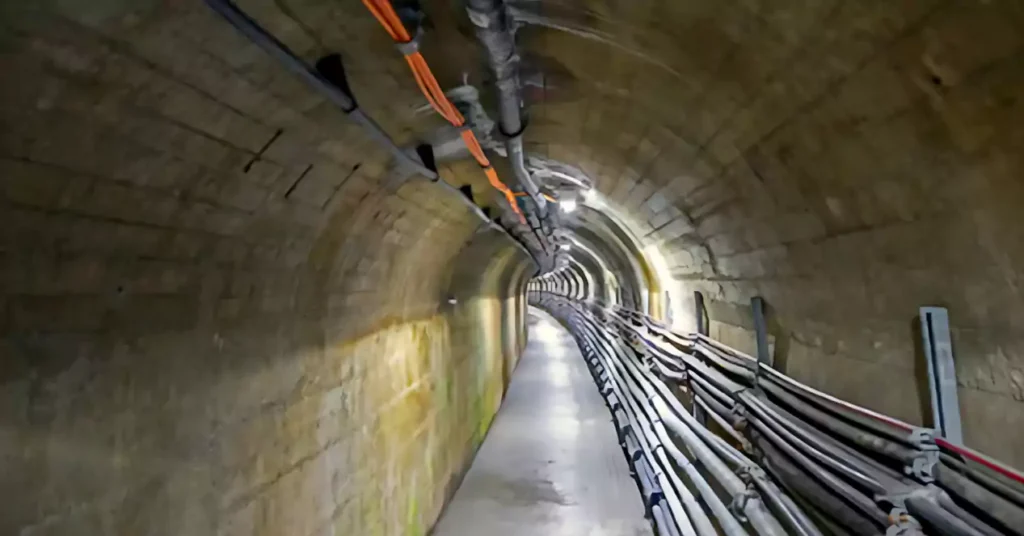
PVC conduit’s versatility allows it to serve a broad spectrum of applications across residential, commercial, industrial, and infrastructure environments.
1. Underground Electrical Systems
PVC conduit is extensively used for underground electrical installations, especially for residential and commercial service entrances, utility duct banks, and roadway lighting.
Why PVC?
Rigid PVC conduit is non-corrosive and does not degrade when exposed to moisture or soil chemicals.
It is approved for direct burial without requiring additional protective coatings.
Available in long lengths, minimizing the number of joints (reducing potential failure points).
DB-rated (Direct Burial) and EB-rated (Encased Burial) PVC conduits are specially designed for this purpose.
التطبيقات:
Residential underground service entrance raceways
Power and telecom duct banks
Street lighting circuits
Highway ITS and traffic signal cabling
Utility vaults and manhole raceways
2. Outdoor and Above-Ground Exposed Environments
UV-resistant PVC conduit is ideal for outdoor electrical runs, especially in coastal, humid, or chemically aggressive atmospheres.
PVC conduit is:
Resists corrosion from salt air, moisture, acid rain, and chemicals
UV-stabilized formulas withstand long-term sunlight exposure
Lightweight, easy to install on exterior walls or rooftops
التطبيقات:
Solar PV system conduit runs on rooftops or carports
Agricultural and irrigation pump control wiring
Outdoor lighting or pole bases
Exterior conduit risers and raceways
RV parks, marina shore power, and outdoor recreational areas
3. Wet and Damp Locations
PVC conduit performs well in areas classified as damp or wet by electrical codes, especially where metallic systems would corrode over time.
Why PVC Conduit?
Nonmetallic construction eliminates risk of rust or galvanic corrosion
Compatible with watertight fittings and gaskets
Non-conductive, reducing shock hazard in wet environments
التطبيقات:
Parking garages
Commercial kitchens
Pools and spas
Cold storage and refrigerated facilities
4. Residential Construction
PVC conduit is commonly used for residential wiring, especially in slab-on-grade homes or areas with corrosive soil or water exposure. Its:
Easy to cut and glue with solvent cement
Inexpensive and simple to route through floors, walls, or slabs
Compatible with NM cable transitions and standard junction boxes
التطبيقات:
Conduit sleeves through concrete slabs
Garage and utility room wiring
Exterior meter-to-panel conduit
Service entrance risers
Ground-mounted AC units and pool panels
5. Commercial and Institutional Buildings
While EMT and MC cable are more common indoors, PVC conduit is often used in commercial buildings in certain areas or for specific systems.
Why PVC Conduit?
Offers nonmetallic raceway option for corrosive or damp spaces
Compatible with ENT (Electrical Nonmetallic Tubing) for concealed walls and ceilings
Fire-rated LSZH and plenum-rated types available for code-required areas
التطبيقات:
Utility rooms, mechanical chases, and crawlspaces
Parking structures and exterior lighting
Fiber and low-voltage system raceways
Fire pump and generator wiring conduits
Commercial rooftop installations
6. Industrial Environments
PVC conduit is well-suited for light-to-medium duty industrial applications, particularly in areas with chemical exposure or moisture.
Why PVC Conduit?
Withstands exposure to oils, acids, salts, and alkalis
Non-conductive for safer installations near combustible materials
Easily integrated with other nonmetallic raceway systems
التطبيقات:
Agriculture and aquaculture environments
Battery storage systems and chemical warehouse
Conveyor or material handling system control wiring
7. Renewable Energy Systems

PVC conduit is a common choice for solar, wind, and EV charging infrastructure.
PVC conduit is:
UV-resistant options for rooftop and outdoor installations
Compatible with direct burial from array to inverter or EV charger
Available in wide diameters to accommodate DC cabling and future upgrades
التطبيقات:
Solar PV combiner to inverter runs
DC and AC conduit between arrays and control panels
Underground feeders to energy storage or transformers
EV charging conduit raceways (Level 2 or DC Fast Charging)
Off-grid system power distribution
9. Hazardous and Classified Locations (Limited Use)
Although metal conduits dominate classified environments, specialized heavy-duty PVC conduit systems may be used in corrosive classified areas when permitted by code.
With proper fittings and enclosure types, PVC conduit can be applied to:
Wastewater lift stations with classified zones
Chemical process areas (Specific class)
Oil field and agricultural gas areas (with approval)
Always consult the NEC, CEC, or local code authority to confirm suitability for hazardous locations.
Ledes' Solution for PVC Conduit Systems
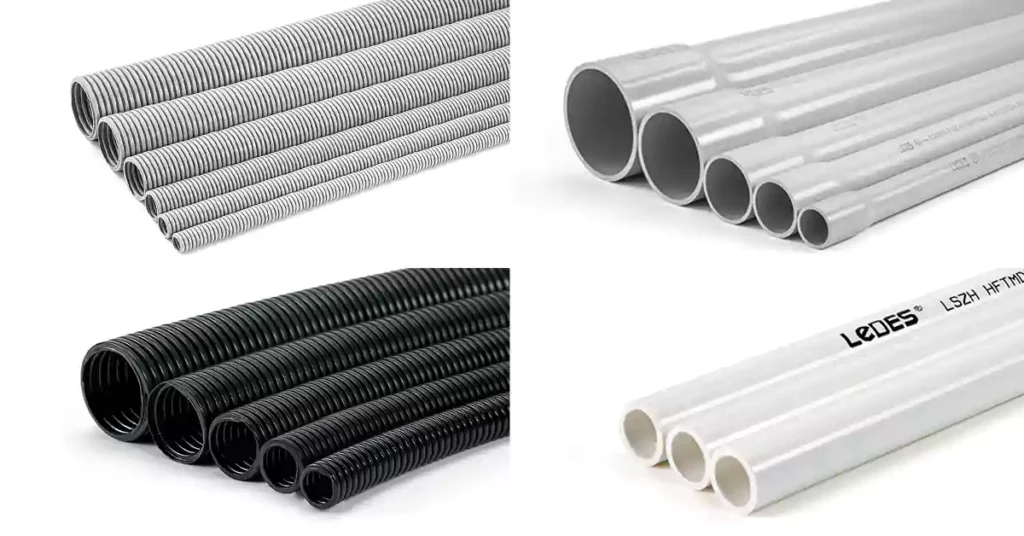
When selecting the right PVC conduit system, choosing a reliable manufacturer is just as important as selecting the right conduit type. With over 10 years of industry expertise, Ledes has become a global name in electrical conduit solutions, recognized for its product breadth, engineering capabilities, and international code compliance.
Whether you’re installing residential underground ducting, industrial wiring, solar energy conduit runs, or large-scale infrastructure, Ledes offers a PVC conduit solution engineered for performance, safety, and long-term reliability.
Comprehensive Product Portfolio
Ledes manufactures a full spectrum of PVC conduit types and accessories, serving both low-voltage and high-voltage systems. The product line includes:
أنابيب PVC الصلبة:
– Schedule 40 conduit and Schedule 80 electrical conduit (UL 651, CSA C22.2 No. 211.1 compliant)
– AS/NZS 2053-rated PVC conduit for Australian and New Zealand markets
– Rigid PVC conduit that meet IEC standard
Flexible & Corrugated Conduits:
– UL & CSA certified ENT, standard corrugated, and split-type designs
– Ideal for tight installations, low-voltage systems, and control wiring
– Flame-retardant and UV-stabilized options available
Specialty Solutions:
– أنابيب هالوجين منخفضة الدخان وخالية من الهالوجين (LSZH) for fire-sensitive environments (e.g., data centers, tunnels, rail)
– Solar conduit systems optimized for UV resistance, long-term outdoor exposure, and direct burial
– Direct Burial DB2/ES2 conduits engineered for long underground duct banks and infrastructure raceways
Conduit Fittings & Accessories:
– Elbows, couplings, adaptors, tees, junction boxes, expansion fittings, terminal ends
– Designed for seamless integration and installation efficiency
– Available in standard and customized configurations
Quality You Can Trust
Ledes integrates quality and safety into every stage of the manufacturing process, backed by internationally recognized certifications:
- UL Listed (UL 651 for rigid PVC conduit, UL 514C for fittings)
- CSA Certified for Canadian compliance
- AS/NZS 2053-compliant conduit systems for Australia and New Zealand
- IEC and British Standards compatibility for export and global projects
- NEMA TC-2 and TC-3 compliant for U.S. conduit systems
- ISO 9001:2015 (Quality Management) and ISO 14001:2015 (Environmental Management)
These certifications are supported by a modern production facility that includes:
- Fully automated extrusion lines
- In-house testing for flame resistance, compression, UV aging, and chemical performance
- Custom R&D capabilities for unique formulations, sizes, or color coding
Innovation & Customization
Ledes isn’t just a conduit manufacturer—it’s a solutions partner. The company’s R&D and engineering teams develop custom conduit types for specific regional code needs, emerging industries (like EV and solar), and client-specific branding or logistics.
Customization options include:
Color-coded conduit (e.g., orange for communications, black for solar, gray for general use)
Custom printing and markings for branding or traceability
Special packaging for bulk export or warehouse efficiency
Chamfer design for specific needs
Trusted by Global Infrastructure Projects
Ledes conduit systems have been selected for use in some of the world’s demanding infrastructure and power generation projects:
Champlain Hudson Power Express (CHPE) – United States
A landmark renewable energy transmission line, the CHPE Project is designed to deliver 1,250 MW of clean hydroelectric power from Canada to New York City via a 339-mile HVDC cable.
- Ledes supplied high-performance PVC conduit systems for underground electrical raceways, supporting clean energy transmission infrastructure
- Significance: A major U.S. green infrastructure initiative projected to power over 1 million homes
A.B. Brown Generating Station – Indiana, USA
Located in Posey County, Indiana, the A.B. Brown Station is a 700-MW coal and natural gas power generation facility operated by CenterPoint Energy.
- Ledes’ conduit systems are used for control wiring and infrastructure upgrades during facility modernization
- Environment: Demanding industrial site requiring chemically resistant and direct burial-rated conduit
Al Dhafra PV2 Solar Project – Abu Dhabi, UAE
This is the world’s largest single-site solar photovoltaic project, with a capacity of 2 GW and a project budget exceeding $1 billion USD.
Ledes’ Role: Supply of UV-resistant, heavy-duty solar PVC conduit and fittings for power collection systems, inverters, and monitoring equipment
Installation Conditions: Harsh desert environment with extreme heat, sand exposure, and long cable routing distances
Melbourne Metro Tunnel – Victoria, Australia
A transformative infrastructure project, the Melbourne Metro Tunnel adds two 9-km twin rail tunnels and five new stations to Melbourne’s rail network. With a $12.6 billion AUD budget, it is the largest investment in Melbourne’s public transport system in 40+ years.
Ledes’ Role: Supply of AS/NZS 2053-compliant PVC conduits and fire-rated low-smoke halogen-free (LSZH) systems
9 Things You Need to Know Before Buying an Electrical Conduit
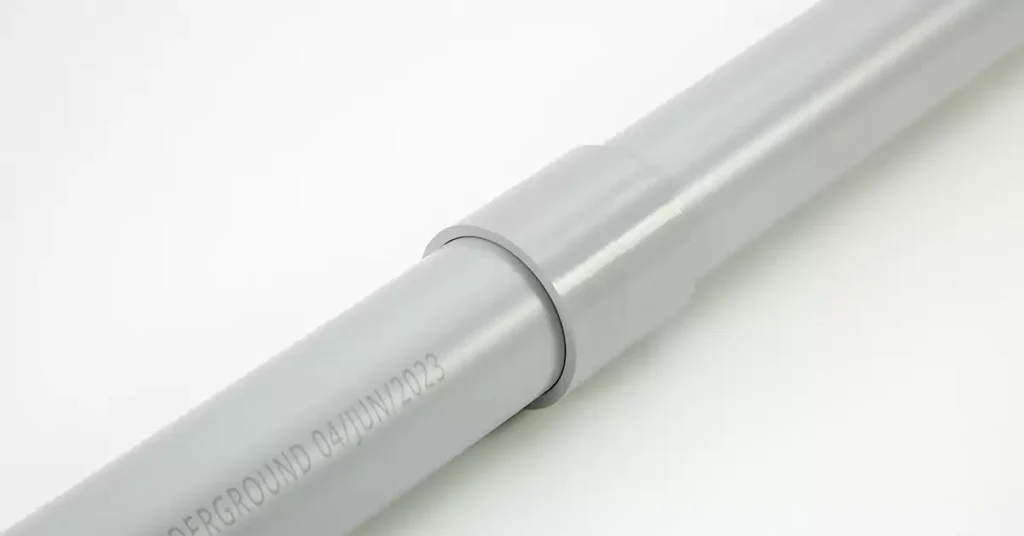
Choosing the correct electrical conduit isn’t just about material or diameter—it’s about aligning technical specifications, safety requirements, code compliance, and installation conditions with your actual project needs. Whether you’re a contractor, engineer, facility manager, or procurement specialist, making an informed purchase decision helps avoid costly replacements, failed inspections, or performance failures down the line.
1. Installation Environment
Your installation location is the single biggest factor influencing conduit type, rating, and accessories.
Always ask, is the conduit run indoor or outdoor?
Is the site exposed to heavy loads, UV radiation, chemicals, moisture, salt air, or extreme temperatures?
نصائح:
Use UV-resistant PVC for outdoor exposure
Select direct-burial (DB2/ES2 or Schedule 40 underground-rated) for soil-embedded installations
For corrosive or damp areas, nonmetallic PVC is ideal
For tunnels, subways, or data centers, consider Low-Smoke Halogen-Free (LSZH) PVC conduit
2. Voltage and System Type
The voltage level and system function (power, communications, control, etc.) impact conduit sizing, material, and separation rules.
Consider:
Is it a low-voltage system (under 1000V), or medium/high-voltage?
Is the conduit for data, fiber, fire alarm, or control circuits?
Are multiple systems being routed together?
Key Tips:
PVC conduit is suitable for low and medium-voltage installations
For high-voltage, verify fire resistance, insulation, and clearance
Always follow code rules for system separation (e.g., power vs. signal)
3. Conduit Size and Cable Fill Capacity
You must match the conduit inner diameter (ID) to the cable type and quantity being pulled. Improper sizing may result in overheating, jamming, or code violations.
Ask:
How many conductors will be installed, and what are their sizes?
Are you planning for future cable capacity?
Key Tips:
Follow NEC Chapter 9 Table 1 or equivalent standards for maximum fill percentage
Oversizing is recommended for easy pulls and future expansion
Include space for pull strings or additional circuits if needed
4. Mechanical and Impact Strength Requirements
Depending on your environment, you may need conduit with extra resistance to physical stress, such as crushing, bending, or surface impact.
Ask:
Will the conduit be driven over, embedded in concrete, or subject to machinery movement?
Is it installed in a public area, plant floor, parking garage or other applications where under heavy loads?
Key Tips:
Use Schedule 80 PVC for greater wall thickness and impact resistance
Consider concrete encasement or steel conduit alternatives for high-impact zones
5. Regulatory Code Compliance
Always verify that the conduit meets applicable electrical codes and national standards for your country or region. Such as UL, CSA, IEC, AS/NZS and other required compliant standards.
6. Fittings and Compatibility
Even the best conduit is only effective if paired with the right fittings, such as connectors, adaptors, junction boxes, and sealing gaskets.
Use same-brand conduit and fittings when possible for guaranteed compatibility
Check fitting material (e.g., PVC, nylon, or polycarbonate) for environmental fit
Consider expansion fittings for long outdoor runs exposed to thermal cycling
7. Fire Safety and Flame Rating
In commercial or enclosed environments, fire resistance and smoke emission are critical safety factors.
Use LSZH conduit and fittings or look for flame-retardant rated conduit, such as V-0, 5VA, or UL 94 rated products.
8. Project Budget and Lifespan Expectations
PVC conduit is generally one of the most cost-effective options on the market. It’s not only affordable upfront, but also saves on labor thanks to its lightweight design and ease of installation.
However, it’s important to consider long-term durability, for applications where exposed extreme heavy loads, temperatures, or with strict fire safety requirements etc, metal conduits maybe more suitable even they are more expensive.
9. Manufacturer and Supply Chain Reliability
Conduit systems are often ordered in large volumes, choosing a trusted brand ensures availability, quality, and technical support.
Choose suppliers who offer certified products, global logistics, and technical engineering consultation
Avoid unknown brands without test reports or regulatory listings
Market Trends and Future Outlook
The global electrical conduit market is evolving rapidly in response to technological demands, safety regulations, and sustainability initiatives. For PVC conduit specifically, opportunities are expanding beyond traditional construction into areas like digital infrastructure, renewable energy, and smart buildings. This section explores the most critical trends shaping the future of conduit systems and what they mean for procurement and product planning.
1. Steady Market Growth with Strategic Shifts
The global electrical conduit pipe market is valued at approximately US$ 34.3 billion in 2024, and is projected to reach US$ 54.8 billion by 2034, with a compound annual growth rate (CAGR) of 4.8%. The U.S. market alone is expected to grow from US$ 6.5 billion in 2024 to over US$ 10.5 billion by 2034, showing strong demand in residential, commercial, and infrastructure sectors.
Meanwhile, countries like China and Japan are showing CAGRs around 5.0%, driven by smart city developments and industrial electrification.
2. IT, Telecom, and Data Centers Drive High-Margin Growth
One of the fastest-growing segments is IT and telecommunications, which includes cloud computing, data centers, streaming infrastructure, and edge computing. The global data center rack market will grow from USD 5.17 billion in 2025 to USD 9.42 billion by 2030 at a compounded annual growth rate (CAGR) of 12.7%. These applications demand nonmetallic conduit with high EMI resistance, fire ratings, and cable density management, making high-spec PVC conduit (e.g., LSZH or fiber-optic-rated) a strong fit.
Buyer Insight:
While general construction projects contribute the most volume, the tech sector represents the most specialized and profitable conduit demand, requiring close technical support and advanced product offerings.
3. Resilient Demand in Building and Construction
The backbone of PVC conduit sales remains the residential, commercial, and institutional building sector. Growth is driven by:
Reinvestment in aging infrastructure
Demand for energy-efficient buildings
Increased emphasis on code-compliant wiring protection in both new builds and retrofits
PVC conduit remains the preferred nonmetallic solution due to its cost-efficiency, corrosion resistance, and compatibility with concrete slab, underground, and outdoor installations.
4. Stricter Electrical Safety Standards
With growing global awareness around electrical safety, regulatory enforcement is tightening:
OSHA and NEC updates in the U.S.
CSA and CE code harmonization in Canada and Europe
AS/NZS 3000 (Australia/NZ) focus on LSZH and fire-safe wiring systems
IEC 61386 global alignment for conduit systems
These changes are driving demand for certified conduit systems, particularly UL- and CSA-listed PVC, flame-retardant, and low-smoke halogen-free options for use in hospitals, transport, and tunnels.
5. Smart Buildings and IoT Integration
The rise of smart buildings and energy-efficient infrastructure is reshaping conduit system needs. Smart lighting, building automation, and energy monitoring systems all rely on low-voltage, sensor-integrated, and modular conduit installations.
PVC conduit plays a key role here due to:
Non-conductive safety
EMI isolation for sensitive control wiring
Compatibility with fiber, CAT6, and low-voltage systems
The ability to route data and control cabling alongside traditional wiring is transforming how PVC is used in commercial and public buildings.
6. Green Energy Projects and Renewable Infrastructure
PVC conduit is increasingly used in:
Utility-scale solar farms
EV charging networks
Battery energy storage systems (BESS)
Off-grid power distribution
As the conduit industry shifts toward more technically complex, code-sensitive, and environmentally conscious applications, the demand for high-quality conduits is growing. To know more about the PVC pipe forecast and market insights to 2031, click here for more information.
خاتمة
Selecting the right PVC electrical conduit is not just about choosing a product, it;s about ensuring electrical safety, regulatory compliance, long-term durability, and project success. As we’ve explored throughout this guide, the best choice depends on a careful evaluation of installation environment, voltage requirements, conduit type, mechanical strength, and certification needs.
PVC conduit stands out in the market for its balance of cost-efficiency, ease of installation, corrosion resistance, and broad code acceptance. From residential wiring to complex infrastructure and renewable energy projects, it remains a dependable choice across sectors.
With increasing global demand for smart buildings, high-performance data systems, and sustainable infrastructure, the conduit market is becoming more specialized. Manufacturers must apply to this transformation to offer conduits that ensure electrical systems’ integrity and longevity for years to come.
الأسئلة الشائعة
ما هو العامل المحفز لنمو سوق الموصلات الكهربائية؟
تشمل عوامل النمو الرئيسية توسع قطاع تكنولوجيا المعلومات والاتصالات، وزيادة نشاط الإنشاءات، وتشديد لوائح السلامة، وتزايد الطلب على المباني الذكية والبنية التحتية للطاقة المتجددة. تُعزز هذه العوامل الطلب على أنظمة توصيل موثوقة ومتوافقة مع المعايير في جميع أنحاء العالم.
لماذا يعتبر أنبوب PVC خيارًا صديقًا للبيئة؟
PVC conduit pipes are increasingly seen as a sustainable option due to their durability, corrosion resistance, and lower environmental footprint compared to metal conduits. Their manufacturing requires less energy and emits fewer greenhouse gases, and their lightweight nature reduces transportation emissions. PVC is also 100% recyclable, reducing the need for virgin materials and promoting a circular economy. Furthermore, PVC conduit systems require minimal maintenance, reducing resource consumption over their lifecycle.
ما الذي يجب أن آخذه في الاعتبار عند اختيار القناة المناسبة لمشروعي؟
Important factors include:
Installation location (indoor, outdoor, buried)
Voltage and cable type
Mechanical stress exposure
Code compliance
Fire and environmental conditions
Future expansion plans
Costs and budge
Matching conduit specifications to your site requirements ensures safety, durability, and easier inspections.
How do recent NEC updates impact conduit installations?
The NEC updates introduce expanded requirements for surge protection in residential services , new provisions for Energy Management Systems (EMS) and coordination with renewable systems (solar, battery storage, EV chargers). There are also expanded requirements for outdoor emergency systems , and clarifications for branch circuit sizing, AFCI/GFCI placement , and bending space for larger conductors. These changes necessitate careful planning of conduit routing, sizing, and material selection to ensure compliance and avoid costly delays.
How is conduit used in smart buildings and automation systems?
Smart buildings require extensive low-voltage and data cabling for IoT devices, sensors, and control systems. PVC conduit is ideal for protecting these circuits while maintaining EMI isolation and code compliance in energy-efficient, automated environments.
Why is code compliance so important when selecting conduit?
Compliance with electrical codes like NEC, CEC, AS/NZS 3000, or IEC ensures safety, legality, and reliability. Code-listed conduit is tested for flame resistance, mechanical strength, and insulation. Non-compliant installations may lead to project delays, insurance issues, or safety risks.
What services should B2B buyers look for in a conduit manufacturer?
Professional buyers should seek suppliers who offer:
Certified, tested products (UL, CSA, AS/NZS, IEC)
Custom sizes, packaging, and markings
Engineering support for system design
Global logistics and inventory management
Strong after-sales service and technical documentation
What types of PVC conduit are best for underground installations?
For underground use, Schedule 40 or 80, DB2/ES2, or DB and EB conduits are typically recommended. Ensure the conduit is marked for burial use and is UV-stabilized if transitioning to above-ground exposure.
Can PVC conduit be used in high-temperature environments?
Standard PVC conduit normally used in temperature under 75°C, but it can used with 90°C wires if it is certified. For high-heat areas, look for temperature-rated or thermally modified formulations, or consider metal or specialty conduit types rated for thermal stability.
Is PVC conduit flame-retardant or fire-rated?
Standard PVC offers basic flame resistance. For enhanced safety, choose Low-Smoke Halogen-Free (LSZH) PVC or products tested to UL 94 V-0, 5VA, or IEC 61386 fire standards. These are essential for use in tunnels, transport hubs, and enclosed buildings.
Can I mix conduit types in the same installation?
Yes, but all conduits must be compatible with installation standards, conductor ratings, and grounding requirements. Transitions (e.g., from PVC to EMT) must use listed adapters or couplings and meet code.
مراجع:


